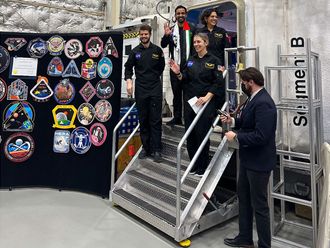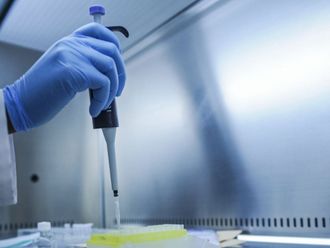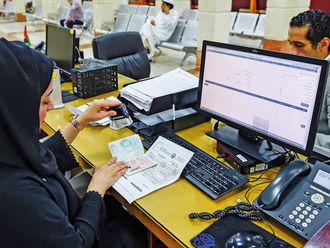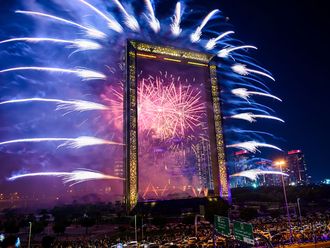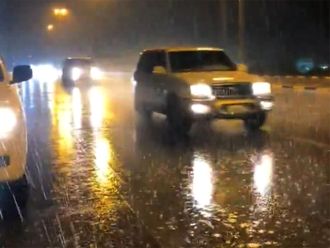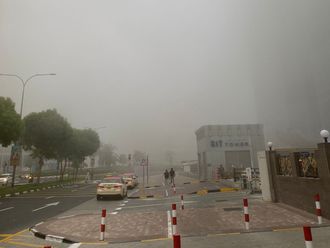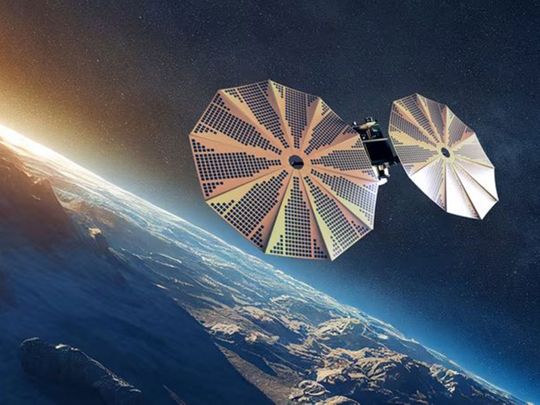
Dubai: The UAE on Monday unveiled another significant milestone in its space exploration programme with the launch of the ‘UAE Asteroid Belt Exploration Project.’
The ambitious initiative was launched by His Highness Sheikh Mohammed bin Rashid Al Maktoum, Vice President and Prime Minister of the UAE and Ruler of Dubai, at a ceremony at Qasr Al Watan in Abu Dhabi.
‘MBR Explorer’, the mission’s spacecraft named after Sheikh Mohammed, will blast off to space in March 2028, the UAE Space Agency (USA) officials announced later at a press conference in Dubai. They said it will be the “world’s first multiple-asteroid tour and landing mission” to the Main Asteroid Belt between Mars and Jupiter.
Sheikh Mohammed said: "The Emirates Mission to the Asteroid Belt is a massive scientific project that will result in the establishment of private Emirati companies specialised in space science and technology, the development of a deep space mission control centre, and the training of Emirati talent.”
He added: "The Emirates Mission to the Asteroid Belt will cover 10 times the distance covered by the ‘Hope Probe’. Emirati youth believe in the motto that 'The Impossible is Possible'.
"The secret behind our 5-billion-kilometre space mission is our belief in the capabilities of our youth, and our efforts to support them in achieving their ambitions."
Sarah Al Amiri, Minister of State for Public Education and Advanced Technology and Chairwoman of the UAE Space Agency, said: “The EMA is a key component of the UAE National Space Strategy and has one over-riding goal – the creation of viable and rewarding employment opportunities for young Emiratis for generations to come. Emirati learning, knowledge transfer and innovation lie at the heart of the EMA. The mission will contribute to empowering local private sector companies and UAE start-ups."
Salem Butti Salem Al Qubaisi, the UAE Space Agency's Director General, said: “In addition to extensive research, development and finance, long-term space missions require extensive cooperation with local and global institutions and the private sector. We are keen to expand strategic partnerships with the local private sector to ensure the success and accelerated growth of our future space projects.”
During the press conference, Mohsen Al Awadhi, director of Space Missions Department who is also the project lead of the asteroid mission, and Hoor Al Mazmi, deputy project scientist, provided further details of the project.
Duration of the project
“It is a 13-year mission with six years of development and seven years of exploration,” said Al Awadhi.
The mission will see the Emirati-built explorer travelling 5 billion kilometres into deep space.
Al Awadhi said the mission is scheduled to launch in March 2028. There will be a three-week launch window to perform its mission.
The Explorer will fly by the Earth, Mars and six asteroids and will have a planned landing on the final asteroid in 2034.
Al Mazmi said the mission will explore the final asteroid for seven months and send back valuable data for the global scientific community.
Mission’s objective
The officials said the mission involves exploring seven asteroids, with a focus on water-rich asteroids to better understand the source of water on Earth and other planets.
“The mission aims to study the evolution and origin of these asteroids and gain insights into the formation processes of planets in the solar system. It will specifically study water and minerals on these asteroids with an aim to make use of them as resources for future space exploration projects,” said Al Mazmi.
Various instruments, including two cameras and two spectrometers, will be used to gather data and achieve these objectives.
Which are the asteroids?
The seven asteroids that the UAE spacecraft will explore are 10253 Westerwald Asteroid, 623 Chimaera Asteroid, 13294 Rockox Asteroid, 88055 Asteroid, 23871 Asteroid, 59980 Asteroid and finally the 269 Justitia Asteroid.
“The asteroids that we chose are very significant in that they represent five different families of asteroids, and they represent a diverse set of asteroid classes and types. The final asteroid that we’re going to is the most significant asteroid specifically because it is one of the two reddest asteroids and the main asteroid in the belt. That’s the asteroid that we’re also landing on,” said Al Mazmi.
She said the mission will study the Justitia Asteroid, using the four science instruments.
The key questions for exploring the mysterious rock with a reddish hue with possible origins from the distant solar system, will be: “What are its origins? Did it migrate from the Kuiper belt? Why is it unusually ultra-red?”
Al Mamzi said: “We will be looking at volatiles and then complex organics on the surface. And those are all going to tell us about the history and evolution of those asteroids.”
Al Awadhi said the mission would at least confirm that those asteroids are water rich as they are assumed to be. “And if not, how is it different and so on.”
Making use of the water and minerals to fuel the future space explorations is one of the main objectives.
Massive spacecraft
The MBR Explorer will be a massive spacecraft weighing around 2.8 tonnes, according to Al Awadhi.
“In Emirates Mars Mission [EMM], we had approximately [a weight of] 1,400kg. Today, we are close to double that,” he said.
It will have the most advanced thrusters ever used in a space mission and travel at an average speed of 33,000km/h.
The MBR Explorer’s four science instruments include a high-resolution camera, a thermal infrared camera, a mid-wavelength spectrometer and an infrared spectrometre. Together, these instruments will support observations that will measure the surface composition, geology and interior density and structure of asteroids across five of the main belt ‘families’, helping to better understand the origins and evolution of water-rich asteroids and also to assess the resource potential of asteroids and prepare the way for future asteroid resource utilisation.
“We are developing 50 per cent of the mission based on the experience that we received while developing the Emirates Mars Mission. But this mission is going into a deeper space as compared to EMM’s Hope Probe,” said Al Awadhi.
He pointed out that the challenges and opportunities are manifold. “The solar panels designed for the project are 10 times bigger than the ones designed for EMM.”
The project’s scope also is 10 times that of the ‘Hope Probe’ mission.
National team
Considering the complex nature of the project, a national team involving officials, researchers, engineers and other experts from the UAE Space Agency and its various partners are working on the project.
Currently, Al Awadhi said, close to 80 team members are directly working with the mission.
“They are all coming from different entities, sectors, companies, regardless of private or government, or startups, all under the same umbrella which is what we are calling the national team.”
He said private companies in the UAE play a major role in developing the mission alongside the Laboratory for Atmospheric and Space Physics in the University of Colorado Boulder which had helped build the Hope Probe.
The lander of the spacecraft will be developed fully by two Emirati startup companies specialising in space technologies and will use the resources available in the UAE.
Ali Al Suwaidi, founder of 971 Space and Maryam Al Nabooda, founder of Sadeem Space Solutions, shared the excitement about their startup companies working on the ambitious project.
Meanwhile, Abdullah Essa Sharif, senior engineer for research and development, said: “The UAE is building a vibrant space sector. It is a new field filled with challenges. But it also has opportunities in the UAE for investment and high returns from a scientific perspective.”
How students will benefit
Al Awadhi said various programmes have been developed to engage students in the mission, including the research programme and in engineering aspects.
“We recognise the importance of universities as key players, particularly in the science field. We are in discussions with them to prepare PhD students and determine the required areas of expertise. Our focus is to involve students not only in science but also in engineering and technical aspects,” he said.
New York University Abu Dhabi, Khalifa University and the UAE University have already been partnered into the project.
The mission’s academic partners include Khalifa University; the New York University Abu Dhabi (NYUAD); the National Center for Space Science and Technology at UAEU; University of Colorado Boulder; the Italian Space Agency Agenzia Spaziale Italiana (ASI); Arizona State University & Northern Arizona University and Malin Space Science Systems. Contributors to the mission include Emirati national companies and institutions such as TII and Yahsat, as well as local and global private space sector partners.
UAE's space milestones
2009: The UAE launched its first Earth observation satellite DubaiSat-1. It provided impressive mid-resolution images that were utilised for sustainable development, urban planning, and monitoring environmental changes in the UAE.
2013: The second satellite Dubai Sat-2 was launched. It contributed to the scientific knowledge development and incorporated innovative specifications and technology, surpassing the capabilities of previous satellites.
2017: The UAE’s first nanosatellite Nayif-1 was launched. It helped to develop the space technology industry skills of Emirati engineering students and provided them with hands-on experience in the design, manufacture, integration, installation and operation of small satellites.
2018: Khalifa Sat, the first satellite fully designed and developed in the UAE was launched. It has been capturing and transmitting high-quality detailed images of Earth, serving various critical purposes such as monitoring environmental changes, facilitating urban management, and supporting disaster relief efforts.
2019: The UAE Astronaut Programme launched ‘Zayed’s Ambition’ with Hazzaa Al Mansouri becoming the first Emirati astronaut to reach the International Space Station. During his eight-day stay on the ISS, Al Mansouri conducted various experiments and research in collaboration with international astronauts.
2020: The Emirates Mars Mission, the first Arab interplanetary mission was launched with the Hope Probe. After completing its two-year mission in exploring Martian orbit with massive data, it recently made e groundbreaking observations of Mars' smaller moon, Deimos.
2021: DM Sat-1, the first nanometric environment satellite in collaboration with Dubai Municipality was launched. The first UAE Analog Mission was also launched in the same year.
2022: The Emirates Lunar Mission, the first Emirati mission to the surface to the moon, was launched. Subsequently, it became the first Arab lunar rover to enter the Moon’s orbit.
2023: UAE Astronaut Mission 2 was launched with astronaut Sultan Al Neyadi embarked on the longest Arab space mission to the International Space Station. He also became the first Arab to conduct a spacewalk or Extravehicular Activity outside the ISS.
2023: Rashid 2 Moon Rover was announced to continue the journey into the Moon’s surface.
2024: MBZ-Sat, the region’s most advanced high accuracy, high resolution imaging satellite will be launched.
2028: MBR Explorer of the UAE Asteroid Belt Exploration Project will be blasting into space with a target of covering 5billion kilometres to study the asteroids in the Main Asteroid Belt between Mars and Jupiter.
2117: The UAE’s most ambitious space project “Mars 2117” is envisioned to build the first human settlement on Mars by 2117.



